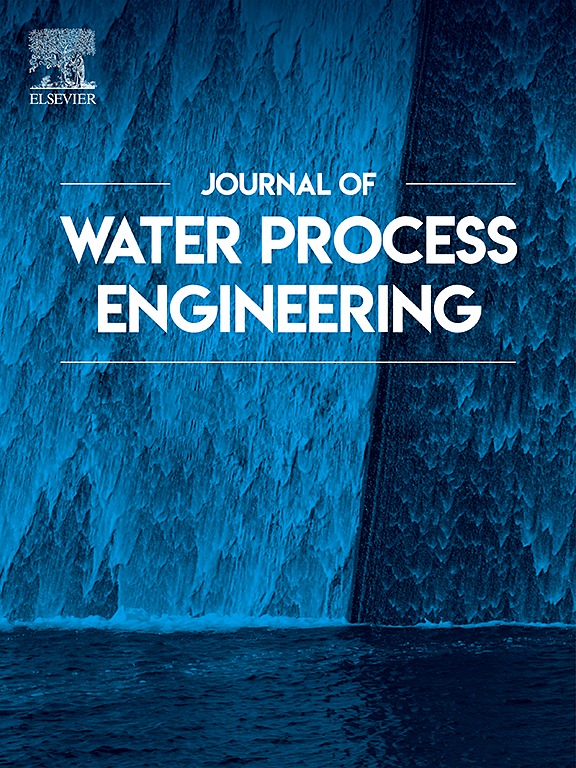住宅管道系统滞水生物膜群落结构及影响因素
IF 6.3
2区 工程技术
Q1 ENGINEERING, CHEMICAL
引用次数: 0
摘要
了解生物膜细菌群落对确保饮用水微生物安全具有重要意义。本研究通过模拟住宅管道系统,探讨管道材料、供水方式、预处理方法(超滤和紫外线)对住宅管道系统生物膜微生物生长和群落结构的影响。在本研究中发现,铜管由于腐蚀而产生的较高粗糙度有利于生物膜的附着和生长。在生物膜形成初期,预处理降低了生物膜的生物量和多样性。通过冗余分析,证明铜管中的金属离子是影响生物膜群落结构的关键因素。此外,群落组装机制分析表明,不同的群落组装过程导致铜管中生物膜群落结构与其他管道不同。为了进一步了解生物膜中的细菌如何适应低营养环境,利用网络分析揭示了微生物倾向于相互合作以适应低营养环境。总的来说,这项工作为生物膜在住宅管道系统中的应用提供了生态学的见解。本文章由计算机程序翻译,如有差异,请以英文原文为准。
Community structure and influencing factors of biofilms in stagnant water of premise plumbing system
Understanding biofilm bacterial community is important for ensuring the microbial safety of drinking water. This study uses a simulated premise plumbing system to investigate the effects of pipe material, water supply mode, and pre-treatment methods (ultrafiltration and ultraviolet) on microbial growth and community structure in biofilms within premise plumbing system. It was found that higher roughness of copper pipes due to corrosion facilitates biofilm adhesion and growth in this study. Pre-treatment decreased the biomass and diversity of biofilm in the initial stage of biofilm formation. Based on Redundancy analysis, the metal ions in copper pipes were proved to be the key reason of influencing biofilm community structure. Besides, analysis of the community assembly mechanisms revealed that different community assembly processes lead to different biofilm community structures in copper pipes compared to other pipes. To further understand how bacteria in biofilms adapt to oligotrophic environments, the use of network analysis revealed that microorganisms tend to cooperate with each other to adapt to oligotrophic environment. Overall, this work provides ecological insights into biofilm in premise plumbing system.
求助全文
通过发布文献求助,成功后即可免费获取论文全文。
去求助
来源期刊

Journal of water process engineering
Biochemistry, Genetics and Molecular Biology-Biotechnology
CiteScore
10.70
自引率
8.60%
发文量
846
审稿时长
24 days
期刊介绍:
The Journal of Water Process Engineering aims to publish refereed, high-quality research papers with significant novelty and impact in all areas of the engineering of water and wastewater processing . Papers on advanced and novel treatment processes and technologies are particularly welcome. The Journal considers papers in areas such as nanotechnology and biotechnology applications in water, novel oxidation and separation processes, membrane processes (except those for desalination) , catalytic processes for the removal of water contaminants, sustainable processes, water reuse and recycling, water use and wastewater minimization, integrated/hybrid technology, process modeling of water treatment and novel treatment processes. Submissions on the subject of adsorbents, including standard measurements of adsorption kinetics and equilibrium will only be considered if there is a genuine case for novelty and contribution, for example highly novel, sustainable adsorbents and their use: papers on activated carbon-type materials derived from natural matter, or surfactant-modified clays and related minerals, would not fulfil this criterion. The Journal particularly welcomes contributions involving environmentally, economically and socially sustainable technology for water treatment, including those which are energy-efficient, with minimal or no chemical consumption, and capable of water recycling and reuse that minimizes the direct disposal of wastewater to the aquatic environment. Papers that describe novel ideas for solving issues related to water quality and availability are also welcome, as are those that show the transfer of techniques from other disciplines. The Journal will consider papers dealing with processes for various water matrices including drinking water (except desalination), domestic, urban and industrial wastewaters, in addition to their residues. It is expected that the journal will be of particular relevance to chemical and process engineers working in the field. The Journal welcomes Full Text papers, Short Communications, State-of-the-Art Reviews and Letters to Editors and Case Studies
 求助内容:
求助内容: 应助结果提醒方式:
应助结果提醒方式:


